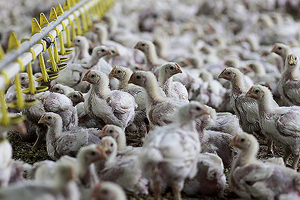Reducing coccidiosis in broilers

Research trials have shown that metabolites in Diamond V Original XPC empower the immune system to defend the bird against destructive invaders.
Research has shown that Original XPC strengthens the innate response (Jensen et al,2008) and supports adaptive immunity (Gao et al, 2008) within the gastrointestinal (GI) tract. Chemical signals (cytokines) help suppress the inflammatory response during a challenge (Jensen et al, 2008), and metabolites in Original XPC increase antibody production to commercial vaccines (Al-Homidan and Fahmy, 2007; Fathi et al, 2012).
Previous work has also demonstrated that feeding Original XPC can reduce the incidence and severity of intestinal lesions when birds are challenged with coccidiosis (Lensing et al, 2012). Further evidence of reduced coccidiosis stress from feeding Original XPC is the improved body weight gain when birds were fed Original XPC during a coccidia challenge (Gao et al, 2009; Paiva et al, 2010).
The current study was designed to investigate the individual and combined effects of Original XPC and a coccidiostat (Salinomycin) during a coccidiosis challenge in broiler chickens.
Test birds were housed and lesion scores were conducted at Southern Poultry Research near Athens, GA. Male broilers (Cobb X Cobb) were used in this study from 0d to 27d of age. All birds received vaccinations at the hatchery for HVT and SB1. Chicks were weighed at 0d and randomly assigned to treatment / cage. All birds were weighed at 0d, 21d and 27d of age. Feed consumption was measured at 21d and 27d. Five treatments were included in this study with 8 birds per cage and 8 replicate cages per treatment.
All birds in T2 –T5 were challenged orally with a coccidia inoculum at 21d (Oocytes: 75,000 E. acervulina, 25,000 E. maxima and 75,000 E. tenella). The challenge dose per bird was designed to be much greater than a routine field challenge and to produce approximately 3.0 lesion scores for each species in the infected, non-medicated control group.
At 27d, all birds from each cage were lesion scored. The upper, middle and cecal regions of the intestine were scored, using the system of Johnson and Reid (1970) where 0 is normal and 1, 2, 3, or 4 indicate increasing severity of infection.
A statistical reduction in E. acervulina coccidia lesion scores was demostrated in the upper GI tract when Original XPC (2.5 lb/t) was included in the feed (T3). Salinomycin (60 g/t) inclusion (T4) further reduced lesions compared to the nonmedicated, infected group (T2).
E. maxima lesion scores in the mid gut were also significantly reduced from the addition of Original XPC to the diets (T3) and theSalinomycin (T4) and to the combination of products (T5). And finally, cecal lesions reflecting E. tenella were also significantly reduced when feeding Original XPC (T3) and an even greater response observed when Salinomycin was included (T4 and T5).













